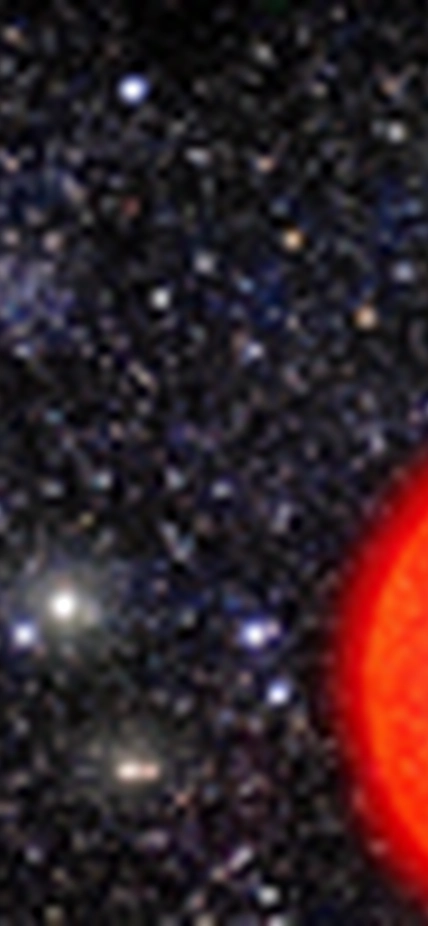A newly discovered star outside the Milky Way has yielded important clues about the evolution of our galaxy. Located in the dwarf galaxy Sculptor some 280,000 light-years away, the star has a chemical make-up similar to the Milky Way’s oldest stars, supporting theories that our galaxy grew by absorbing dwarf galaxies and other galactic building blocks.
Some recent studies had questioned the link between dwarf galaxies and the Milky Way, citing differences between the chemistry of their stars. But the differences may not be so big after all, according to new research published in Nature. “It was a question of finding the right kind of star, and doing that required some new techniques,” says Josh Simon , an astronomer at the Observatories of the Carnegie Institution and a member of team that confirmed the star’s telltale chemistry. Using earlier techniques, he says, “it was very difficult to recognize exactly which stars were the key ones to study.”
Dwarf galaxies are small galaxies with just a few million stars at most. They often orbit larger galaxies such as the Milky Way, which consists of hundreds of billions of stars. In the “bottom-up model” of galaxy formation, proposed in 1978 by Carnegie astronomers Leonard Searle and Robert Zinn (now at Yale University), large galaxies attained their size over billions of years by swallowing up their smaller neighbors. But if dwarf galaxies are the building blocks of larger galaxies, then the same kinds of stars should be found in both types of galaxies, especially in the case of old, “metal-poor” stars. (To astronomers, “metals” are chemical elements heavier than hydrogen and helium.) Because they are products of stellar evolution, metals were rare in the early Universe, and so old stars tend to be metal-poor.
Stars in the Milky Way’s halo can be extremely metal-poor, with metal abundances as much as 100,000 times less than the Sun, which is an average metal-rich star. Surveys over the past decade had failed to turn up any such extremely metal-poor stars in dwarf galaxies. “The Milky Way seemed to have stars that were much more primitive than any of the stars in any of the dwarf galaxies,” says Simon. “If dwarf galaxies were the original components of the Milky Way, then it’s hard to understand why they wouldn’t have similar stars.”
Simon and his colleagues suspected that the methods used to find metal-poor stars in dwarf galaxies were biased in a way that caused the surveys to miss the most metal-poor stars. Team member Evan Kirby, a Caltech astronomer, developed a method to estimate the metal abundances of large numbers of stars at a time, making it possible to search efficiently for the most metal-poor stars in dwarf galaxies. Among stars he found in the Sculptor dwarf galaxy was one designated S1020549. Spectroscopic measurements of the star’s light at Carnegie’s Magellan-Clay telescope in Las Campanas, Chile, determined it to have a metal abundance more than 4,000 times lower than that of the Sun―five times lower than any other star found so far in a dwarf galaxy.
“This star is likely almost as old as the universe itself,” said astronomer Anna Frebel of the Harvard-Smithsonian Center for Astrophysics, lead author of the Nature paper reporting the finding.
In addition to the star’s total metal abundance, researchers also compared the abundance of iron to that of elements such as magnesium, calcium, and titanium. The ratios resembled those of old Milky Way stars, lending more support to the idea that these stars originally formed in dwarf galaxies.
The researchers expect that further searches will discover additional metal-poor stars in dwarf galaxies, although the distance and faintness of the stars pose a challenge for current optical telescopes. The next generation of extremely large optical telescopes, such as Carnegie’s proposed 24.5-meter Giant Magellan Telescope, equipped with high-resolution spectrographs, will open up a new window for studying the growth of galaxies through the chemistries of their stars.
In the meantime, says Simon, the unusually low metal abundance in S1020549 study marks a significant step towards understanding how our galaxy was assembled. “The original idea that the halo of the Milky Way was formed by destroying a lot of dwarf galaxies does indeed appear to be correct.”
Image Caption: Artist's conception of the extremely metal-poor red giant star S1020549 surrounded by other stars the Sculptor dwarf galaxy. Image credit: David Aguilar, CfA. For more images go to http://www.cfa.harvard.edu/~afrebel/sculptor.html
